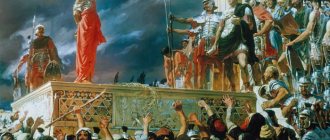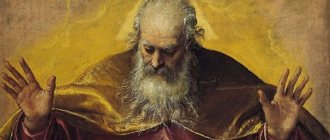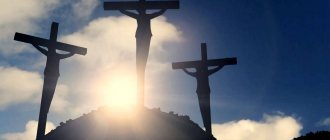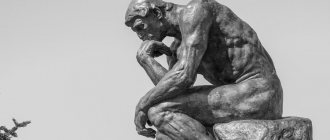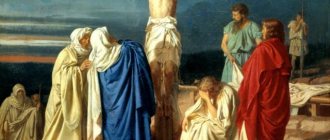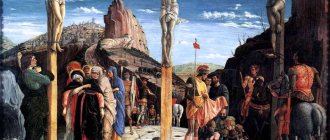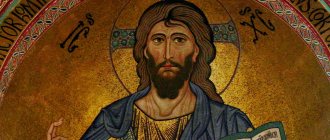Not everyone knows that everyone who participated in the crucifixion of Jesus Christ died a terrible death. The high priest Caiaphas did not escape his fate. At the same time, he predicted his death.
The fact is that when Christ did not deny that he was the Son of God before Caiaphas, he flew into a rage and tore his priestly robes. By this act he deprived himself of the right to the priesthood and condemned himself to death.
The Law of Moses said that the high priest should not tear his clothes under threat of death (Lev. 10:6) Caiaphas soon died in great torment, and on the site of his house the Church of St. Peter in Gallicantu was erected - it was here that Peter denied Jesus .
The high priest Caiaphas is mentioned several times in the Gospel
Caiaphas and Anna
Caiaphas (Yoseph Bar-Cayaphas, Hebrew יוֹסֵף בַּר קַיָּפָא, Greek Καϊάφα (the name, probably from Aramaic, means “humility”, according to other sources, “researcher”) - high priest of Judah and from 18 to 37 Josephus mentions him, calling him Joseph, nicknamed Caiaphas (Jewish Antiquities, Book XVIII, 2.2).
There are also sources in which he is also called Caiaphas from Greece. Caiaphas is mentioned many times in the three Gospels (Matt. 26:3, Matt. 26:57, Luke 3:2, John 11:49-52, John 18:13-28), as well as in the Acts of the Apostles (Acts. 4:6).
This occurs first in the story of John the Baptist (Luke 3:1-2). He later appears in the story of the Passion of the Lord; in the house of Caiaphas the fate of Jesus Christ is finally decided: (John 11:46-53).
The procurator of Judea Pontius Pilate and the high priest Caiaphas in a modern image. Pontius Pilate appointed Caiaphas to the position of high priest. Photo: xn--80aebqdeap5ate.xn--p1ai
It is known that the procurators ruled the province of Judea with the help of the high priests they appointed. Caiaphas was the high priest of the Temple for 18 years. He was appointed to this post by Valery Grat, predecessor of Pontius Pilate.
The consul Aulus Vitellius, the future emperor of Rome, removed him from power. Caiaphas was a Sadducee, son-in-law of the high priest Annas (Hannan), and an obedient instrument in the hands of his father-in-law.
Cephas was high priest for eighteen years.
Even after leaving his post, Anna continued to tenaciously hold power in his hands and, in fact, had sole control over temple posts and the treasury.
According to some historians, it was Annas, through his son-in-law, who made the decision to execute Jesus as one of those rebellious preachers with whom Judea was flooded at that time.
These preachers blasphemed the authority of the Roman emperor and predicted the imminent arrival of the Messiah and the renewal of the world.
Many legends were and are told about the life and death of the high priest Caiaphas. For example, it is believed that he himself predicted his death when he tore his priestly robes at the trial of Jesus Christ.
Legends also say that he died in agony, and this was his punishment for an unjust trial.
Notes[ | ]
- Josephus Flavius. Jewish antiquities
- Ernest Renan. Life of Jesus (unspecified)
(unavailable link). Retrieved July 10, 2008. Archived July 19, 2008. - Kosidovsky Z. Tales of the Evangelists
Archival copy dated April 19, 2009 on the Wayback Machine - ↑ 12
Derevensky B. G. Near-Gospel artifacts - Biblical archaeology. Ossuary of Caiaphas (unspecified)
(inaccessible link). Access date: July 10, 2008. Archived February 25, 2008.
The High Priest is the head and commander of the priests in the Jewish Church
High Priest
The high priest in the Jewish church was considered the senior and first priest (2 Chron. 19:11). He was the head and commander of the priests in this church. The first high priest was Aaron.
Then they became his successors from the oldest families of his descendants. Ordination to the rank of high priest was performed according to a special rite and was distinguished by an abundant outpouring of peace on the head of the initiate.
The clothes of the high priest were more majestic and valuable than the clothes of ordinary priests. A description of this ceremony and the high priestly vestments is found in Exodus 28 and Exodus 29 and Lev 8.
Priesthood of the Jewish Church. In the Jewish church, the high priest was its head and he ruled over the other priests. Photo: pravoslavie.ru
The clothing of the high priest on the day of propitiation was simpler than on ordinary days, and consisted only of a smooth linen ephod with a belt around it, which is why the Jews called it white clothing, while the first was called gold.
High priests were usually appointed to this position for life. In the last years of the kingdom of Judah, this high position was occupied by many high priests at the same time, many of them being of bad morals and vicious, such as the high priest Caiaphas.
The High Priest of the Jewish Church was its head.
A particularly solemn and exclusive duty of the high priests was to enter the Holy of Holies and offer sacrifices therein for the sins of the people on the day of propitiation.
In Lev 16 we find a description of this most solemn sacred service. The High Priest was the head of all other priests and alone could enter the Holy of Holies. He stood before the Face of God closest to Him and prayed for all the Israelites.
He was, so to speak, a mediator between earth and heaven and a prototype of the Lord Jesus Christ, the great High Priest who passed through the heavens.
Ossuary of Caiaphas. This ossuary is believed to contain the remains of the high priest's son, Joseph Ciathas, and his son. Photo: hrampokrov.ru
There is historical evidence of the existence of the high priest Caiaphas. So in November 1990, during the construction of a water park in Jerusalem, in an area called the “Forest of Peace,” a burial chamber was discovered.
It was sealed around the time of the second Jewish War (70). The chamber was divided by partitions into four parts, where there were 6 intact and 6 split (probably by robbers) ossuaries.
1990
This year a burial chamber from around 70 was discovered in Jerusalem.
It is possible that this ossuary contained the remains of the son of the Gospel Caiaphas, who bore the same name as his father. This is evidenced by the inscription preserved on the ossuary.
In the ossuary, archaeologists found the bones of six people: two infants, one child aged 2 to 5 years, a teenager about 13 years old, an adult woman and a man about 60 years old. Probably the last skeleton belongs to the high priest.
Necessary Steps of Faith for Salvation through Jesus Christ
God did everything necessary for the salvation/redemption of man and for the acquisition of eternal life. And therefore he, in turn, calls:
- “Repent therefore and be converted, so that your sins may be blotted out (erased) ” (Acts 3:19),
- “ Believe in the Son of God ” (John 3:16).
But what do these proclamations mean and what do they represent? Repentance mean according to the word of God ? What does conversion, transformation ?
faith expressed ?
The following six steps will help us better understand God's requirements and consciously accept his invitation to conversion.
- Awareness of man's sinfulness
- Confession of sins
- Request for forgiveness of sins
- Accepting forgiveness and justification through faith
- The decision to leave a sinful life
- Willingness to be baptized
Figure 2: A tombstone that reminds visitors to a garden tomb in Jerusalem of the resurrection of Jesus Christ on the first day of the week (Photo: April 1986).
The High Priest Caiaphas condemned Christ to death in advance
The history of the Passion of the Lord indicates that the high priest Caiaphas condemned Jesus Christ to death in advance. This is what the Gospel says:
“And some of them went to the Pharisees and told them what Jesus had done. Then the chief priests and Pharisees held a council and said, “What should we do?”
This Man does many miracles. If we leave Him like this, then everyone will believe in Him, and the Romans will come and take possession of both our place and our people.
One of them, a certain Caiaphas, being the high priest that year, said to them: you know nothing, and you will not think that it is better for us that one person should die for the people, than that the whole people should perish.
He did not say this on his own, but, being high priest that year, he predicted that Jesus would die for the people, and not only for the people, but in order to gather together the scattered children of God. From that day on they decided to kill Him.”
(John 11:46-53)
Meeting of the Great Sanhedrin. American Encyclopedia 1883 The High Priest Caiaphas at one of the meetings of the Sanhedrin suggested that the Sadducees execute him. Photo: pravoslavie.ru
Researchers point to the fact that Caiaphas was the high priest in Judea for this particular year. The fact is that the Law of Moses requires the installation of a high priest for life. The Romans began to violate it by appointing a high priest annually.
Thus, in the year of Christ’s execution, Pontius Pilate confirmed Joseph Caiaphas in this position. There is also a version that at this time there were two high priests in Judea: Annas and Caiaphas, who performed their duties in turns.
As for the words “one man must die” and “die for the people,” historians believe that they indicate that Jewish society at that time had strong communal traditions.
There is a version that at the time of Christ there were 2 high priests in Judea: Annas and Caiaphas.
As for the execution of Jesus Christ itself, after its meeting the Sanhedrin began to look for false witnesses against Him in order to put Him to death, but could not find them. Finally, two false witnesses were found. They began to talk about what Jesus said: I can destroy the temple of God and build it in three days.
This is how slanderers distorted the words of the Lord when He said some time ago on Easter: “...destroy this temple, and in three days I will raise it up...”. At the same time, the Savior spoke in a similar way about His death and three-day resurrection.
Video: The trial of Jesus Christ by the Jewish high priests. At 35 seconds the author talks about the trial of the Jewish high priests over Christ
After this, standing up, the high priest Caiaphas said to Christ: “I adjure you by the living God, tell us, are you the Christ, the Son of God?” Jesus answered him: “Yes, I am. And you will see the Son of Man sitting at the right hand of power and coming on the clouds of heaven.”
Then the high priest, as a sign of deep sorrow and indignation, tore his clothes and said: “He is blaspheming! What more need do we need witnesses? Behold, now you have heard His blasphemy, as it seems to you.”
And the members of the Sanhedrin said in response: “He is guilty of death.” Jewish court order forbade the death penalty to be passed at night. To formally comply with this requirement, early in the morning the Sanhedrin met again and decided to betray the Lord Jesus Christ to death.
Links
| Caiaphas on Wikisource |
Places Garden of Gethsemane • Sanhedrin • Golgotha Jesus and disciples Jesus Christ • Virgin Mary • Mary Magdalene • Mary of Cleopas • John the Theologian • Apostle Peter • Apostle Mark • Judas Iscariot • Myrrh-Bearing Women Jews Herod Antipas • Caiaphas • Annas • Malchus • Servant the Doorkeeper • Barabbas • Simon of Cyrene • Ahasuerus • The Prudent and the Mad Robbers Romans Pontius Pilate • Claudius Proculus • Centurion Longinus Items Instruments of the Passion: Crown of Thorns • Robe of the Lord/Seamless Chiton • Life-Giving Cross • Titlo INRI • Spear of Longinus • Holy Grail • Thirty Pieces of Silver Iconography Ecce Homo • Shape of the cross of Jesus Christ • Crucifixion (decorative arts) First Temple Zadok • Ahimaaz • Azariah I • Johanan • Jehoiareb • Jehoshaphat • Jehoiada • Phideas • Zedekiah • Azariah II • Hilkiah Post-Prisoners Josiah • Joachim • Eliashib • Joaidah • Johanan • Jaddui • Onias I • Simon I • Simon the Righteous • Eleazar • Manasseh • Onias II • Simon II • Onias III • Jason • Menelaus • Onias IV • Alcimus Hasmonean Dynasty Jonathan Hasmonean • Simon Hasmonean • John Hyrcanus I • Aristobulus I • Alexander Jannaeus • Hyrcanus II • Aristobulus II • Antigonus II Herodians before the Jewish revolt Hanameel the Egyptian • Aristobulus III • Jesus, son of Thabetus • Simon, son of Boethus • Joazar, son of Boethus • Eleazar, son of Boethus • Annas • Caiaphas • Theophilus, son of Ananus • Simon Kanthera, son of Boethus • Elionaeus, son of Kanthera • Ananias, son of Nedeveus • Joseph Kavi, son of Simon • Ananus, son of Ananus • Jesus, son of Damneus • Jesus, son of Gamaliel • Matthias, son of Theophilus • Phannias, son of Samuel Geography Alexander Garden · Bad apartment · Patriarch's Ponds · MASSOLIT · Variety Theater · Professor Stravinsky's Clinic · Judea · Restaurant "Griboedov" · Aquarium Garden · Yalta · Sparrow Hills Film adaptations film 1972 (Germany, Poland) · TV series 1972 (Yugoslavia, Italy) · TV series 1989 (Poland) · film 1994 (Russia) · TV series 2005 (Russia) · film 2005 (Hungary) Theater productions play · musical (2009) · musical (2014) · rock opera
Almost nothing is known about how Caiaphas died.
Almost nothing is known about the fate of the High Priest of Judea Joseph Caiaphas after he actually approved the death sentence of Jesus Christ. At the same time, it is clear that the Savior did not call for the destruction of the temple, so this sentence cannot be considered fair.
In this regard, the legend of his terrible death began to spread among the people, although we do not know how Caiaphas died.
The fact is that he is not mentioned anywhere else in the Gospel and historical sources. It is only known that after the execution of Christ, he gave up the post of high priest to one of the sons of Anna, of whom, as is known, there were five.
The Trial of Caiaphas, Orthodox icon. Having torn his priestly robes, Caiaphas lost his high priesthood. Photo: pravoslavie.ru
It is quite possible that Caiaphas’s resignation was connected with his unexpected act. The fact is that during the trial of Christ, he committed the most unexpected but significant act - he tore the priestly robes in a rage.
Trying to put pressure on the judges and achieve the condemnation of Christ, the high priest himself condemned himself, since he lost his right to the priesthood. After all, according to the law of Moses (Lev. 10:6), the high priest was not supposed to tear his clothes under threat of death.
Having torn his priestly robes, Caiaphas ceased to be a high priest.
Among the Jews there was a custom of tearing clothes during the death of loved ones, but even this custom did not apply to priests.
The priest's clothes had to be made from a single piece of cloth and shine with cleanliness, since they were intended for service in the temple and symbolized the Great Reality. When priestly vestments were not used in worship, they were kept in the temple.
Step: Admitting Sinfulness
This step begins with recognition: I, too, belong to those who have fallen away from God, and therefore I am lost.
- King David expressed this recognition/awareness in the following words: “Behold, I was conceived in iniquity, and my mother gave birth to me in sin” (Psalm 51:7).
- When meeting with the holy God, the prophet Isaiah exclaims: “And I said: woe is me!” I'm dead! For I am a man of unclean lips, and I live among a people also of unclean lips, and mine eyes have seen the King, the Lord of hosts” (Isaiah 6:5).
- Simon Peter, who later became an apostle: “Seeing this, Simon Peter fell at the knees of Jesus and said: Depart from me, Lord! because I am a sinful man” (Luke 5:8).
In the light of God's holiness, a person loses the desire and need to make excuses for omissions or wrong actions. He no longer even thinks of representing or presenting his good deeds before God. Indeed, a person will be able to see and feel God's favor, his grace, his mercy only when he dares to take this first step. This step does not require huge efforts or feats, just an honest confession:
God, you're right and I'm guilty,
God you are holy, and I am a sinner, and therefore lost .
Images of Caiaphas are often found on icons
Images of the high priest Caiaphas are often found in the cycles of the Passion of Christ.
For the first time, individual scenes and cycles of the Passion with the participation of this character appear in Christian art in the 4th century. on the reliefs of sarcophagi, which, due to the theme of the images, were called “Passionate”, as well as on carved ivory plates decorating the reliquaries.
One of the earliest examples of the image of Caiaphas is the scene “Christ before the Sanhedrin” on the lid of the reliquary (lipsanoteca) from the museum in Brescia (IV century).
Christ before Caiaphas (Matthias Stom, 1630s). The plot of Caiaphas' trial over Jesus Christ is popular in secular painting. Photo: upload.wikimedia.org
This scene is part of a cycle of 6 compositions, which are arranged in 2 registers, and is placed in the lower register next to the scene “Bringing to Pilate. Pilate washes his hands."
On the left side of this composition there are 2 high priests sitting on a throne, one of them points his finger at Jesus Christ, who is held by two servants.
Although the vestments of the Jewish high priests are described in detail in the Bible (Exodus 28), they are not followed literally in Christian art. The high priests on the lid of the reliquary are depicted beardless, with short curly hair, dressed in long clothes (tunics and himation).
Images of Caiaphas on icons have appeared since the 4th century.
In ancient Russian art of the late 15th century. Passionate subjects begin to appear on icons. On the Novgorod tablet (late 15th century), in the scene “Bringing to Anna and Caiaphas,” the latter is sitting at the table next to Anna.
He is depicted without a headdress and in a robe torn to the waist. Caiaphas in these scenes appears in robes imitating the historical clothes of the Jewish high priests - in a high turban hat, long lower robe and short upper robe (ephod).
He is also depicted in a series of Russian engravings of the 17th-18th centuries.
By leaving a comment, you accept the user agreement
Step: Repentance and conversion (confession of sinful life)
Due to the fact that a person is sinful by nature, then accordingly his way or system of thinking and acting is wrong. This can be seen and observed already in children, but God counts sin only when a person, already responsible, consciously violates God’s commandment. Thus Jesus says: “If I had not come and spoken to them, they would not have had sin; but now they have no excuse for their sin ” (John 15:22). Therefore, Peter calls on the people: “Repent therefore and be converted, so that your sins (crossed out) ” (Acts Apostle 3:19).
The invocation word ` repent` (Greek μετανοίσατε - metanoisate) means rethinking, changing thinking. The call ` turn back` corresponds to the Greek `υπεστρέψατε - upestrepsate` and contains the meaning come back. This radical change in thinking and at the same time the rejection of the previous wrong way of life is not primarily an action, but nevertheless it is a necessary step towards God. We see this radical change in thinking in the “ prodigal son ” in Heb. Luke 15:17-19: “When he came to himself, he said, How many of my father’s hired servants have bread to spare, but I am dying of hunger; I will get up and go to my father and say to him: Father! I have sinned against heaven and before you and am no longer worthy to be called your son; accept me as one of your hired servants."
- „Come to your senses, think."
- „realize"
- „regret “,
- „lament"
- exclamation: “ How wrong I lived and thought !”
Then a look to God, the Father, and ultimately a desire to make a decision to take action: “I will get up, go to my father and say to him: Father!” I have sinned against heaven and before you.”
Just as David could not stand it and confessed his sins to God, saying: “But I revealed my sin to You and did not hide my iniquity; I said: “I will confess my transgressions to the Lord” (Psalm 31:5).
In some cases, public recognition is of great importance, as we read in Acts. 19:17-19: “This became known to all the Jews and Greeks living in Ephesus, and fear fell on them all, and the name of the Lord Jesus was magnified. Many of those who believed came, confessing and revealing their deeds. And of those who practiced sorcery, quite a few, having collected their books, burned them in front of everyone, and added up their prices, and they turned out to be fifty thousand drachmas .”
God does not need a list of our sins, he knows our past well, but it is better for us if we reveal the sins we have committed (Proverbs 28:13). Especially sins associated with superstition and occult activities (Deuteronomy 18:9-15). Examples of this are King David (Psalm 32:5), the tax collector Zacchaeus (Luke 19:1-10), the Apostle Paul (Acts 22:4), and those who believed in Ephesus (Acts 19:17-19). ). Other texts from the Bible in which we find a call and invitation to repent: Ezekiel 18:1-32; Ev. Luke 24.47: Acts of St. 2.37-38; 3.19; 17.30 and others.
New life is expressed in the fruit of the Holy Spirit
Illustration 5. Ripe and tasty fruits that ripen in abundance in Jericho (Photo dated January 24, 2019).
This new, spiritual life manifests itself in completely different ways in a person turned to God and reborn through the Holy Spirit.
- Through speaking in other languages previously unknown to them, and thereby glorifying God, also through prophecy (Acts 10:46; 19:1-7). In the early churches these expressions of the Holy Spirit were, in some cases, evident.
- Through bold testimony for Christ (Acts 7:1-60).
- Through showing joy about salvation, helping others, expressing mercy and hospitality (Acts 16:34).
- Through the obvious manifestation of the joy of salvation and the experience of healing (Acts 8:8).
- Through worship, thanksgiving and praise of God (Luke 17:17-19).
- Through joy and the desire to share material goods with others, and return what was stolen (Luke 19:1-10 (8).
- Through a willingness to forgive others (Acts 7:60; Ephesians 4:32; Matthew 6:14).
- Through the desire and willingness to testify about Jesus to other people (1 Thessalonians 1:8; Mark 5:19-20).
- Through thirst and hunger to the Word of God (1 Peter 2:2; Acts 17:11; Luke 10:39).
- Through the desire to communicate with believers in prayer, the Lord's Supper and the teaching of the Apostles (Acts 2:42; 46-47).
- Through the desire to be with God in prayer (Luke 11:1; Matthew 6:5-6; Ephesians 3:14-15).
- Through the desire to support those in need financially (Acts 4:34; 2 Corinthians 8:1-9).
Now is the time to grow spiritually and discover your God-ordained place to serve your gifts and abilities to the Lord and His church..
Figure 6. Sunrise over Lake Victoria in Tanzania (photo: March 11, 2014). “ But to those who fear the name of the Lord the sun of righteousness will rise, and salvation will rise under its wings ” (Mal 4:2).
Quotes
- ^ a b c d
Metzger, Bruce M.;
Coogan, Michael, ed. (1993). The Oxford Companion to the Bible
. Oxford, England: Oxford University Press. n.. ISBN 978-0195046458. - Bond, Caiaphas
S. 18–19. - Bond, Caiaphas
, n. 86. - Josephus' source is mentioned in Antiquitates Judaicae
20.224–51 and
Against Apion
1.36;
see Bond, Caiaphas
, n. 163, n. 2. - Joseph, Anthill, Book 18 Section 26
- Specter, Michael (14 August 1992). “The tomb may contain the bones of the priest who judged Jesus.” New York Times
. New York: New York Times Company. Retrieved January 11, 2019. - ^ a b
Charlesworth, James H. (2006).
Jesus and Archaeology
. Grand Rapids, MI: William B. Erdman Publishing. pp. 323–329. ISBN 978-0802848802. - Bond, Helen Catherine (2004). Caiaphas: friend of Rome and judge of Jesus?
. Louisville, KY: Westminster/John Knox Press. pp. 4–8. ISBN 978-0-664-22332-8. - CNN staff (06/30/2011). "Israeli authorities: 2,000-year-old tomb is the real deal." CNN. Retrieved 2011-08-26.
- Reilly, Wendell (31 March 2022) [1908]. "Joseph Caiphas." Catholic Encyclopedia
.
3
. New York: Robert Appleton Company. - "Caiaphas - Livy." www.livius.org
. - Vanderkam, James (2004). From Joshua to Caiaphas: The High Priests after the Exile
. Minneapolis, MN: Augsburg Fortress Publishing. item 426. ISBN 978-0800626174. - for example Johann Nepomuk Sepp; Claude-Joseph Drioux; Whittaker, H.A. Gospel Studies, Staffordshire Bible 1984, 2nd ed. 1989 p. 495
- James L. Recegui, "An Illustrated Glossary of Narrative Criticism of the New Testament," in Religions
, 10(3)217), 14. - Gottheil, Richard; Krauss, Samuel. "Caiaphas." Jewish Encyclopedia 1906
.
Jewish Encyclopedia
. Retrieved January 11, 2022. - "Bereishit Rabbah 94:9."
- Acts 4:19–20 NIV
- For a discussion of Tosefta Yevamot 1.10 and other possible rabbinic references, see Bond, Caiaphas
, n. 164, n. 3. - Falk, Harvey (1985). Jesus the Pharisee: A New Look at the Jewishness of Jesus
. Eugene, OR: Wipf & Stock. paragraph 137. ISBN 978-1592443130. - Hostetler, Bob (2008). Bone box
. Brentwood, TN: Howard Books. AS IN B0063KB2OO.
Etymology
The Babylonian Talmud (Yevamot 15B) gives the surname as Kuppai, while the Jerusalem Talmud (Yevamot 1:6) mentions Nekifi
.
In Mishna
Para 3:5 he is referred to as hakKof "Monkey", a play on his name, opposing the Mishnat ha-Chasidim.[19]
Last name Caiaphas
קַיָּפָה has three possible origins:
- from קוּפָּה 'basket', 'tub' meaning יֵּף, from which קַיָּף means 'basket maker' or worker using baskets, for example to sell spices
- "how cute" in Aramaic
- "hollow" or "depression" in Akkadian
Step: Deciding to give up sinful life
If it goes without saying that we protect new, clean clothes from contamination, how much more should a person purified in heart renounce and distance himself from the old, sinful life and protect his new life from contamination by sin.
- To the one healed in the pool of Bethesda, Jesus says: “Sin no more” (John 5:14).
- To the woman whom the Pharisees accused of adultery, Jesus said: “Go and sin no more” (John 8:11).
- To the believers in Rome, the Apostle Paul wrote: “Let not sin therefore reign in your mortal body, so that you should obey it in its lusts; And do not present your members to sin as instruments of unrighteousness, but present yourselves to God as alive from the dead, and your members to God as instruments of righteousness .” (Romans 6:12-13).
- He wrote a similar thing to the Colossians, but more decisively and strictly: “Mortify therefore your members on the earth: fornication, uncleanness, passion, evil lust and covetousness, which is idolatry, for which the wrath of God is coming on the sons of disobedience, to which you also once turned. when they lived between them. And now you put everything aside: anger, rage, malice, slander, foul language of your lips; Do not speak lies to one another, having put off the old man with its deeds and put on the new man, who is being renewed in knowledge after the image of Him who created him” (Colossians 3:5-10).
- To the believers in Ephesus, Paul writes: “If anyone has stolen, do not steal from him, but rather work, doing with your own hands what is useful, so that you may have something to give to the needy ” (Ephesians 4:28).
The time has come to replace old sinful habits with new godly ones with pious content.
Step: Accepting forgiveness and justification through faith
You can repent throughout your life and ask for forgiveness many times, but whoever does not accept the gift of God in faith/trust will again and again leave empty-handed and will never have confidence in salvation.
- Jesus said to one sinner: “Your sins are forgiven.” Your faith has saved you; go in peace” (Luke 7:48-50). She believed and walked with confidence of salvation.
- In the parable of the publican and the Pharisee, Jesus says: “This ( publican ) went home justified ” (Luke 18:14).
Accepting forgiveness is believing God's promise that your sins will immediately be forgiven, your debts will be paid off.
- To the criminal on the cross, Jesus said: “Truly I tell you, today you will be with me in paradise” (Luke 23:43).
Whoever God cleanses, washes away from sin, whom he forgives and whose debt he pays off/destroys, is justified: “ Everyone who believes (Jesus) , ” the Apostle Paul assured the people in Pisidian Antioch (Acts Apostle 13:39). And to the believers in Rome he wrote: “Having been justified by faith, we have peace with God through our Lord Jesus Christ” (Romans 5:1).
Even the prophets already predicted the forgiveness of sins in the New Testament through the sacrifice of the Messiah (Isaiah 53; Jeremiah 31:31-34; Hebrews 8:10-12: 10:16-18; Matthew 26:26-28; Acts of the Ap. 3.19). The Lord promised the people of Israel: “ For I will forgive their iniquities and will remember their sins no more.” “ What bliss for sinners!
Illustration 3. Faith is expressed in the willingness to climb the ladder that Christ lowered into the pit. She expresses herself by being ready to grab the lifebelt thrown by Jesus. She expresses herself in the conscious crossing of the bridge built by Christ through His death and resurrection (drawing by J. Shule, July 22, 2019).
- Acceptance of forgiveness of sins,
- liberation from slavery to sin and spiritual death,
- salvation from eternal destruction
can be clearly expressed in a prayer of thanksgiving.
General sources
- Metzger, Bruce M.; Michael D. Coogan, ed. (1993). The Oxford Companion to the Bible
. Oxford, UK: Oxford University Press. ISBN 0-19-504645-5. - Bond, Helen Catherine (2004). Caiaphas: Friend of Rome and Judge of Jesus?
. Louisville: Westminster John Knox. ISBN 0-664-22332-X. - NETBible: Caiaphas
This article incorporates text from a publication now in the public domain: Gerbermann, Charles, ed. (1913). "Joseph Caiphas." Catholic Encyclopedia
. New York: Robert Appleton Company.
Step: Asking for forgiveness of sins
David asks: “Wash me (God) many times from my iniquity, and cleanse me from my sin ” (Psalm 50:4). “ Create in me a clean heart, O God, and renew a right spirit within me ” (Psalm 50:12; Ezekiel 36:26).
The publican in the Temple asks God: “God!” “be merciful to me, a sinner” (Luke 18:13)!
The criminal on the cross begs Jesus: “Remember me, Lord, when You come into Your Kingdom ” (Luke 23:42)!
The wording of requests for forgiveness can be completely different, but in them we express our admiration, our helplessness and our trust in the Savior. And the Lord says: “ Ask and it will be given to you .”
Step: Ready to be baptized
Water baptism in itself is not necessary for salvation (many did not even have the opportunity to do so), but according to Jesus and the apostles, and according to their practice, it is closely related to repentance, conversion and faith in Jesus Christ.
At his farewell, Jesus said to his disciples: “Go therefore and teach all nations, baptizing them in the name of the Father and the Son and the Holy Spirit ” (Matthew 28:19).
On the day of Pentecost, Peter said to the people: “Repent, and be baptized every one of you in the name of Jesus Christ for the forgiveness of sins; and receive the gift of the Holy Spirit ” (Acts 2:38).
Illustration 4. The Jordan River near Bethany where John the Baptist baptized Jesus. Archaeologists have found the foundations of several ancient Christian churches (Photo: November 7, 2014).
As a result of Peter’s preaching, we read: “So those who gladly received his word were baptized, and that day about three thousand souls were added” (Acts 2:41).
About the jailer in the city of Philippi it is said: “And he himself was immediately baptized (at night) and all his household ” (Acts Ap. 16:33).
The Apostle Paul writes to the Romans: “We were therefore buried with Him through baptism into death, so that just as Christ was raised from the dead by the glory of the Father, we too might walk in newness of life. For if we are united to Him in the likeness of His death, we must also be united in the likeness of His resurrection ” (Romans 6:4-5).

